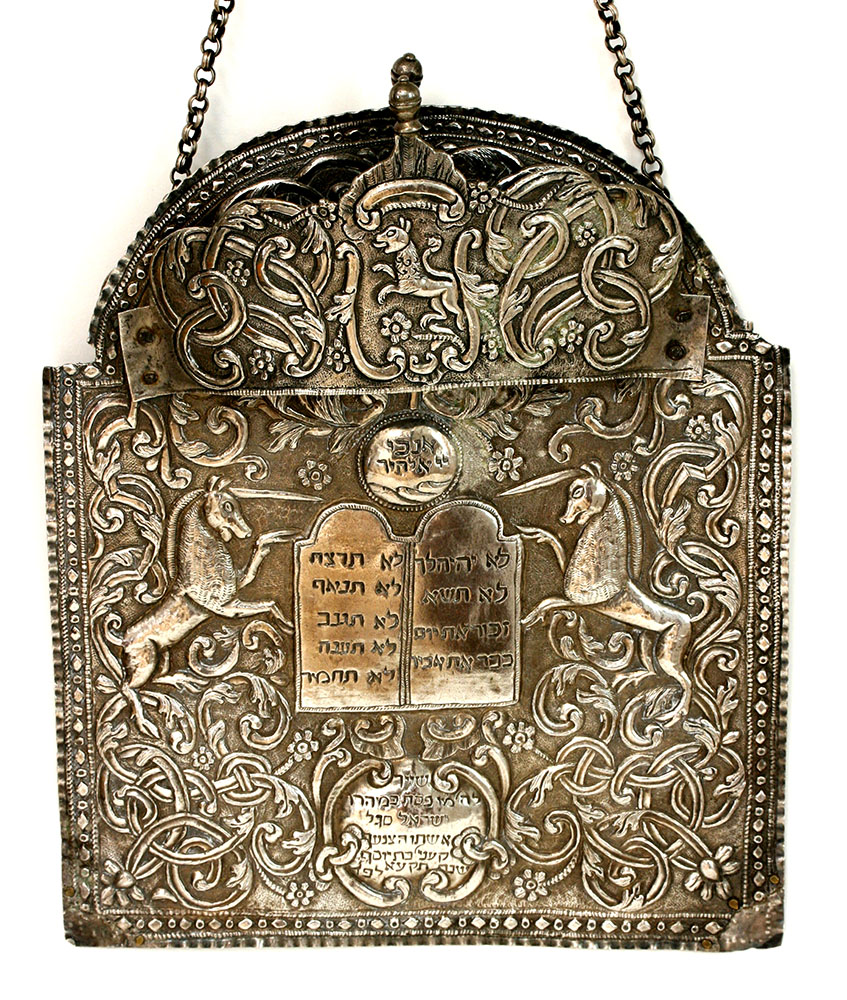The ubiquity of the Ten Commandments on the two tablets in Jewish folk art attests to how central this idea of covenant with God has been in the Jewish tradition. As we saw in the previous post, one might infer various approaches to the question of how that covenant was “held” from the assortment of illustrations found in the Gross Family Collection.
Shomer Emunim, Amsterdam, 1736, Gross Family Collection, Tel-Aviv
In the image above, taken from the title page of Rabbi Yosef Irgas’ book about Lurianic Kabbalah, Shomer Emunim (not to be confused with the book of the same name by 20th century Jerusalem Hasidic leader, Reb Ahrle – Rabbi Ahron Roth) depicts Moses holding the tablets close, as if in a protective posture. One might understand this particular rendition of Moses as describing the “Guardian” of the Jewish Faith par excellence.
But in addition to the prophet’s “protection,” we see heavenly angels or cherubim floating on either side. Could they be yet another layer of “security” for the symbol of the covenant between God and Israel?
The collection has many other images of the two tablets without Moses but flanked by various beings and objects that seem to be protecting them:
In this Mizrah, the tablets stand in front of the Ark, which is depicted according to the description in Exodus, with two cherubim facing each other.
Mizrah, Strasbourg, France, c1835, Gross Family Collection, Tel-Aviv
Of course, in Exodus, the tablets were to be placed inside, not in front of, the Ark. Again, the impression given here is that the angelic figures are protecting the tablets. In addition, although most probably for aesthetic reasons, one might see the priestly censers (incense burners) as additional “defense.”
Here, two cherubim or angels stand beside each of the two tablets:
Amulet, Milan Italy, 1870, Gross Family Collection, Tel-Aviv
Lions are the most common “guardians” of the tablets found on ritual objects. Many see them as a simple symbol of strength. However, since the time of Bible, the lion has also represented the Tribe of Judah, which includes the House of David. Thus a lion is a common symbol for the Messiah in Jewish (as well as Christian) art.
For example, this tas, or breastplate, hung on a Torah Scroll, is quite typical.
Tas, or Torah Breastplate, Slovakia, 1835, Gross Family Collection, Tel-Aviv
Or, on this Menorah, or Hanukkah Lamp:
Hanukkah Menorah, Ukraine, c1860, Gross Family Collection, Tel-Aviv
In at least some circles of Ukrainian Jews or artists of Judaica, under the influence of Christian art, a pair of unicorns might fill in for lions when it came to protecting the tablets:
Tas – Torah Breastplate, Ukraine 1810/1811, Gross Family Collection, Tel-Aviv
Not only animate creatures such as angels, lions and unicorns have flanked the tablets in the Gross Collection. We also find two other types of symbols that are inanimate objects.
The Star of David is a relatively new Jewish symbol, so it’s not surprising that we don’t find this particular kind of image until the 20th century:
Snuff-box, Morocco, c1925, Gross Family Collection, Tel-Aviv
Before the six-pointed star was associated with the modern-day Zionist movement, it was a form of protection used by Jews and other cultures in amulets. That is one way – linked to the examples above – of interpreting the juxtaposition of tablets and Stars of David. Another way of seeing this, in the context of Israel and the Zionist movement, might be that any political solution for the survival of the Jewish people must be linked with the religious and literary tradition.
Perhaps as surprising as a pair of unicorns is the use of cornucopias.
Book binding, Venice, Italy, c1850, Gross Family Collection, Tel-Aviv
Although it’s quite likely that the Horn-of-Plenty was simply a pleasing motif in the eyes of the artist who created this book cover, I find an echo of the rabbinic saying (Avot 3:17) :
Ein kemach, ein Torah; ein Torah, ein kemach.
If there is no food, there is no Torah; if there is no Torah, there is no food.
And then sometimes, it’s not the Torah or Jewish tradition as symbolized by the tablets and the Ten Commandments, but it’s us folks who need the protection, as seems to be the case with this spoon turned amulet:
Amulet, Turkey, c1900, Gross Family Collection, Tel-Aviv
Books, decorations, amulets, breastplates, menorahs, snuff-boxes, book-bindings and even spoons have something to say to us, or at least to offer inspiration, as we continue to reflect upon our spiritual tradition and religious/cultural identities.
Shabbat Shalom











